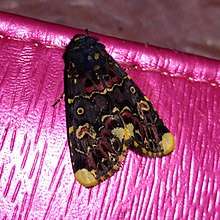Polytela gloriosae
Polytela gloriosae, the Indian lily moth or lily caterpillar, is a moth of the family Noctuidae. The species was first described by Johan Christian Fabricius in 1781.[1] It is found in Sri Lanka,[2] India and probably in Indonesia.[3]
| Polytela gloriosae | |
|---|---|
 | |
| Scientific classification | |
| Kingdom: | |
| Phylum: | |
| Class: | |
| Order: | |
| Family: | |
| Genus: | |
| Species: | P. gloriosae |
| Binomial name | |
| Polytela gloriosae (Fabricius, 1781) | |
| Synonyms | |
| |
Description
The wingspan of the male is 29 mm. Its eyes are hairy and its proboscis is fully developed. Palpi porrect (extending forward) and roughly scaled. Head and thorax are blue black. Antennae orange. Three orange specks are found on the metathorax. Abdomen blackish with orange terminal segments. Forewings blue black. There is an orange speck at the base. Two pink and black lunules run towards the inner margin. Orbicular is yellow with a ring mark. Reniform yellowish. Large orange blotches are found at the apex and outer angle. Hindwings fuscous.[4]
The caterpillar is smooth and purple black. Series of white spots on dorsal, lateral, and sublateral areas. Purplish lateral blotches on thoracic somites. Head and legs are reddish. Early instars are more reddish brown. Body colour turns darker as the caterpillar reaches later instars. Eggs are small spherical and yellow.[5]
Life cycle
The female lays 80 to 90 eggs in 2 to 4 clusters. Eggs are hatched within 4 days. Eggs turn black after 3 days. Larval stage comprises five instars. It takes about 8 to 10 days to complete the larval stage.[6]
- First instar - 3–10 mm long. Head black, body light brown. Gregarious and feeding starts six hours after hatching. Stage lasts for 1-1.5 days.
- Second instar - 1–2 cm long. Head black. Body light brown with white spots. Stage lasts for 1.5 days.
- Third instar - 2–3 cm long. Head black. Body with 5 black spot rows and 6 orange spots. Feed voraciously on leaves. Stage lasts for 2 days.
- Fourth instar - 3-3.8 cm long. Head black. Body with 5 white spot rows on back and 6 orange spots anteriorly and posteriorly. Feeds on tissues. Stage lasts for 2 days.
- Fifth instar - 3.5–4 cm long. Head black. Body with 5 white spot rows and 6 orange spots anteriorly and posteriorly. Feeds on tissues and plant destroyed completely. Stage lasts for 2.5 days.
Pupa obtect. Anterior side broader. Early stages light coloured. It turns dark brownish to blackish in emergence time. Pupation occurs within soil in earthen cell. Stage lasts for 7.5 days.[6]
Biology
The caterpillar is a minor pest on several plants of the families Liliaceae and Amaryllidaceae. Larval food plants include Gloriosa superba, Crinum asiaticum, Zephyranthus grandiflora, Zephyranthus citrina, Scadoxus multiflorus, Amaryllis and Lilium species.[7] They can be controlled using pesticides such as malathion and azadirachtin. Biological control can be used through the fungus Metarhizium and a tachinid fly.[6]
Gallery
.jpg) Dorsal side of adult
Dorsal side of adult.jpg) Underside of adult
Underside of adult.jpg) Caterpillar
Caterpillar Late instar
Late instar Caterpillar
Caterpillar.jpg) Pupa
Pupa
References
- "Species Details: Polytela gloriosae Fabricius, 1781". Catalogue of Life. Retrieved 29 May 2018.
- Koçak, Ahmet Ömer; Kemal, Muhabbet (20 February 2012). "Preliminary list of the Lepidoptera of Sri Lanka". Cesa News. Centre for Entomological Studies Ankara (79): 1–57 – via Academia.
- Savela, Markku. "Polytela gloriosae (Fabricius, 1775)". Lepidoptera and Some Other Life Forms. Retrieved 13 October 2018.
- "Polytela gloriosae Fabricius, 1781". India Biodiversity Portal. Retrieved 29 May 2018.
- "Life Cycle images of Polytela gloriosae (Lily Moth)". Lepidoptera Life Cycle. Retrieved 29 May 2018.
- "Biology, intrinsic rate of increase and control of Indian lily moth Polytela gloriosae (Fab.) (Lepidoptera: Noctuidae)". International Journal of Pharma and Bio Sciences. Retrieved 28 March 2018.
- "Polytela gloriosae (Fabricius)". ICAR-National Bureau of Agricultural Insect Resources. Retrieved 28 March 2018.
| Wikimedia Commons has media related to Polytela gloriosae. |
External links
- Biology of the lily moth, Polytela gloriosae (Fab.) (Lepidoptera: Noctuidae) on Gloriosa superba Linn
- Changes taking place in the electrophoretic haemolymph protein pattern during metamorphosis of Polytela gloriosae
- Asynaptic meiosis in three species of lepidopteran males Arctia ricini, Polytela gloriosae, Precis lemonias 1978
- Late Instar Caterpillar and Metamorphosis of Spodoptera picta Guérin-Méneville (Lepidoptera: Noctuidae: Noctuinae) With Notes On Its Cannibalistic Behaviour